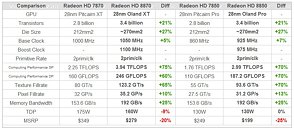Monday, September 17th 2012

AMD "Oland" Radeon HD 8800 Series SKUs Unveiled
Apparently, launch of AMD's Radeon HD 8800 series is close enough for some sources to come up with specifications. The HD 8800 series, according to one source, is based on a new silicon codenamed "Oland," which is built on the 28 nm process, packing 3.4 billion transistors with around 270 mm² die-area. According to the source, the two HD 8800 series models, the HD 8870 "Oland XT" will up performance per Watt and cost-performance ratios over current HD 7800 series, while maintaining current process technologies.
The Radeon HD 8870, according to numbers provided by the source, could offer performance comparable to today's high-end GPUs. The HD 8870 is clocked at 1050 MHz with 1100 MHz PowerTune Boost frequency; while the HD 8850 is clocked at 925 MHz with 975 MHz boost frequency. The memory of both SKUs is clocked at 6.00 GHz, yielding 192 GB/s memory bandwidth. The chips hence have 256-bit wide memory interfaces.Key details such as stream processor, TMU, and ROP counts are excluded, though the source mentions that the HD 8870 provides up to 75% higher single-precision floating point and up to 60% higher double-precision floating point performance over its prdecessor, the HD 7870. The texture fill-rate is up by 65%. The Radeon HD 8850 offers similar increases over its predecessor, the HD 7850. Find them tabled above.
Sources:
Read2ch, VideoCardz
The Radeon HD 8870, according to numbers provided by the source, could offer performance comparable to today's high-end GPUs. The HD 8870 is clocked at 1050 MHz with 1100 MHz PowerTune Boost frequency; while the HD 8850 is clocked at 925 MHz with 975 MHz boost frequency. The memory of both SKUs is clocked at 6.00 GHz, yielding 192 GB/s memory bandwidth. The chips hence have 256-bit wide memory interfaces.Key details such as stream processor, TMU, and ROP counts are excluded, though the source mentions that the HD 8870 provides up to 75% higher single-precision floating point and up to 60% higher double-precision floating point performance over its prdecessor, the HD 7870. The texture fill-rate is up by 65%. The Radeon HD 8850 offers similar increases over its predecessor, the HD 7850. Find them tabled above.

93 Comments on AMD "Oland" Radeon HD 8800 Series SKUs Unveiled
Todays hardware is more than capable of playing games like Metro 2033, Crysis and Witcher 2, the problem is bad coding IMO.
And what do GPU makers have to do with the development of the game, they just pay them to implement their SDKs (3D stereoscopy stuff, nVidia's PhysX, AMD's Global Illumination enhancements and so on...) or render stuff in a certain way as to take advantage of their architecture better, and last, but certainly not least, (which makes up the bulk of it, especially in older TWIMTBP games) pay to have first-hand access to the game's inside, as to optimize their drivers as much as possible for the incoming title. With the shovelware of console ports coming this way, PC has little say in improving how the game looks or runs, GPU makers even less, as they're only a part of PC as a gaming platform.
OTOH, the 7000 series was a complete redesign compared to the 5000/6000 series, and yes there were HUGE gains, but because those gains happened on the compute side, most people don't notice it.
Perhaps the memory bus doesnt make a significant enough difference in performance? , i noticed in max payne3, when i pushed the af [or was it aa] up high, it used much more memory, but not the full 3 gb, maybe around half if i remember, yet the game still jagged out on that setting?
There is always going to be someone worrying about performance loss with older generation cards as AMD releases a new generation on GPUs.